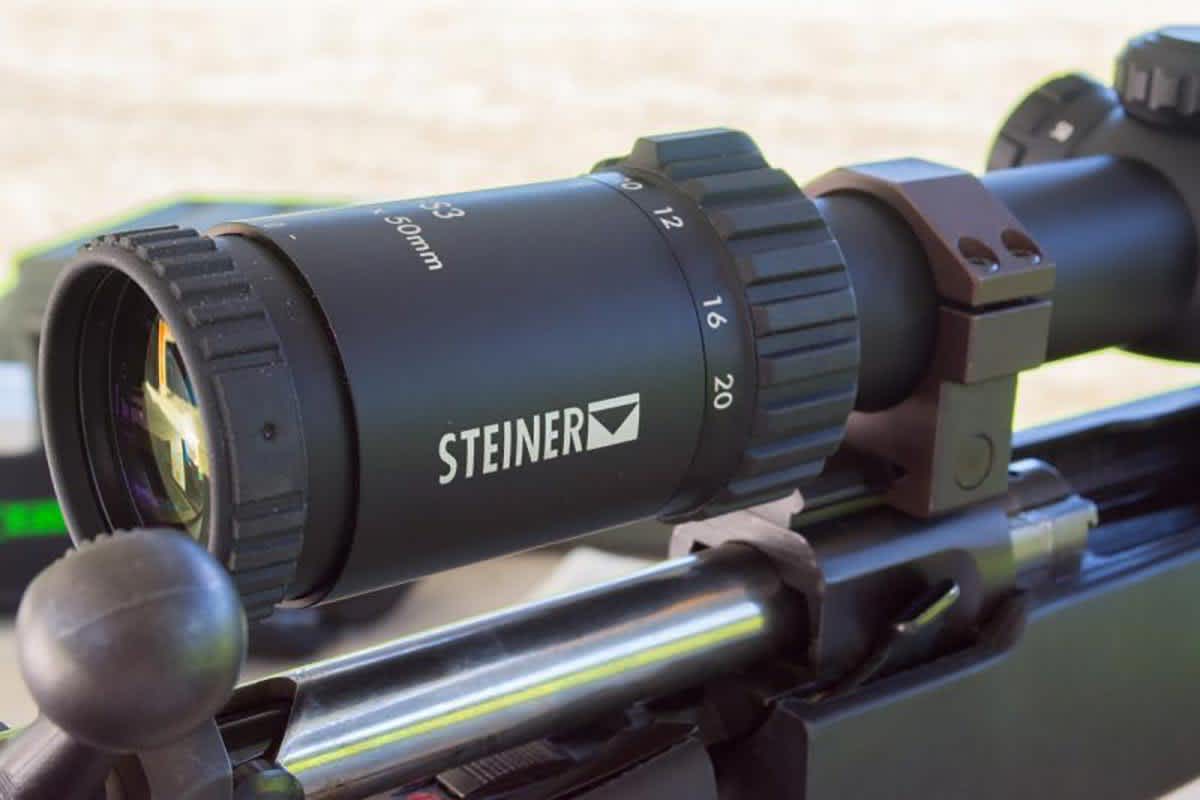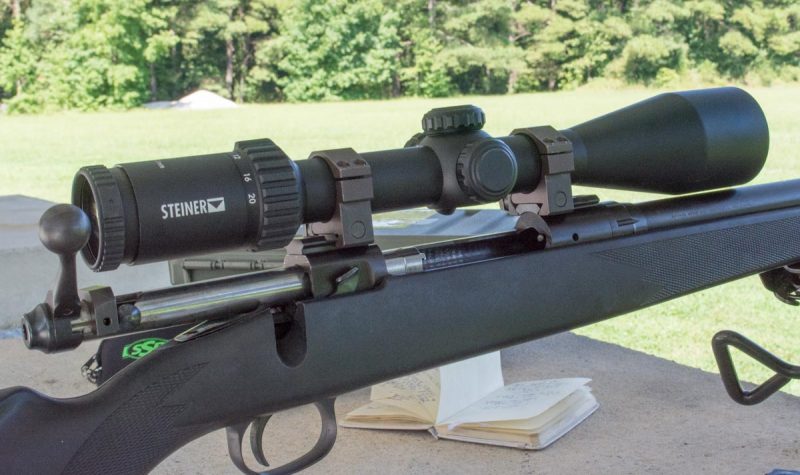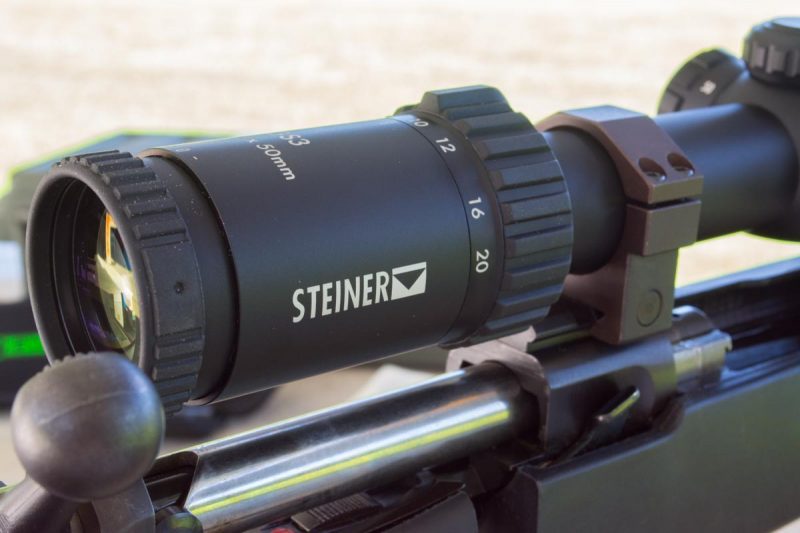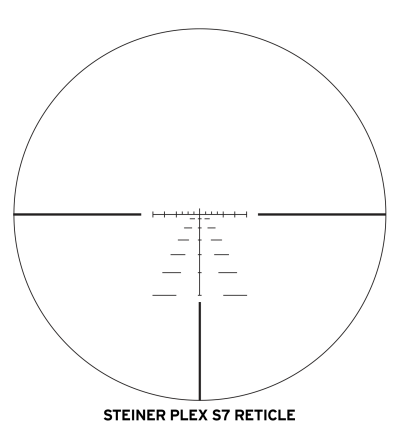Field Test: Steiner GS3 Hunting Scope — A Fast Way to Hit Distant Targets
Tom McHale 08.23.17

One of life’s eternal debates with no clear answer is whether to use a riflescope with field-adjustable turrets, or one with a precisely graduated reticle. If you need to make shots at varying ranges, those two approaches have different pros and cons depending on your specific shooting scenario.
If you have time between shots, field-adjustable target turrets are great. If you know your rifle and ammo ballistic performance, you can spin your elevation dial to the correct minute of angle (MOA) or milliradian (mil) setting and then fire with confidence and a great deal of precision. If you don’t have time to fiddle with turrets before making a shot, using a reticle with graduation marks of some sort allows you to “hold over” to make a first-shot hit at longer distance.

To explore these issues, I borrowed a couple of scopes from the folks at Steiner Optics — one of each style. I have here on my desk a Steiner GS3 4-20×50 with an S-7 reticle and a Steiner T5Xi 3-15×50 with an SCR reticle. The GS3 is an example of a graduated reticle scope, while the T5Xi features exposed target turrets for quick “on the fly” adjustment. Today, we’re going to take a close look at the GS3, and in a future article, we’ll explore the T5Xi in more detail.

GS3 Models and Features
The Steiner GS3 comes in several different models, but all feature the same underlying characteristics. They sport 30mm tube scopes and all use Steiner’s CAT (color adjusted transmission) lens coatings to provide “game sensing” capability through carefully designed contrast tuned to the human eye. That means that the lens coatings are optimized so that human eyeballs see things such as game animals stand out from wooded backgrounds in shadowy light conditions. Within the family, you can choose the following configurations: 2-10×42, 3-15×50, 3-15×56, and the 4-20×50 that we’re looking at here. The first three models have fixed parallax, while the 4-20×50 has a side focus parallax adjustment knob.
The GS3 is built like a tank — there’s nothing fragile or delicate about it. At 28.2 ounces, it’s stout enough to handle the expected knocks and dings in the field, and if things ever get really hairy, it would make suitable impact weapon. The diopter and power wheels feature aggressive ridges and rubberized coating to make changes easy. You won’t need a throw lever on this power wheel to make quick and easy magnification adjustments; a half turn of the wheel will take you all the way from 4x to full 20x magnification.
Windage and elevation turrets are covered with screw-on caps, so the idea of this scope is that you adjust once to set the zero then rely on the reticle for windage and elevation adjustments. Both dials are calibrated to make 1/4-inch at 100-yard impact adjustments for each click. Using the turrets, you have a maximum adjustment range of 64 MOA for elevation and 48 MOA for windage. Just in case you shoot in sunny climates, the interior of the objective lens is threaded, so you can buy a sunshade if you need one.

You can get any of the GS3 models with an A4 reticle or the Steiner Plex S-1/S-7 versions. The A4 is a three-post design with fine crosshairs and an illuminated center dot. There are no elevation graduations. The S-1 reticle offers ballistic compensation elevation lines that are compatible with most big game hunting cartridges. Dots to the sides of those present hold points for a 10-mph crosswind at each distance. If you have a 5-mph crosswind, just hold halfway in between. With the GS3 4-20×50, you can order the S-7 reticle designed specifically for the 22-250 cartridge. The primary horizontal line is for a 100-yard zero, and below that are hold lines for 200, 300, 400, 500, 600 and 700 yards. Extending to the sides are hash marks that show the correct hold for 5- and 10-mph crosswinds at each range. This is the model that got my attention because I think the setup is ideal for long-range varmint hunting.
In the Field

To check it out, I mounted the GS3 on my trusty Savage M112 rifle. This bull barrel bolt-action easily prints half-inch, five-shot groups at 100 yards, so I figured it would be a perfect match for the GS3/S-7 combination. I loaded up a boatload of 22-250 cartridges with my classic favorite recipe of 38/38. In English, that’s 38.0 grains of H380 powder and a ballistic tip 55-grain projectile. Anyway, I wanted to see how my standard load matched up to the ballistic compensation marks on the reticle, so I headed to the long rifle range for some testing.
First, I zeroed the rifle at a range of 100 yards. When I had a satisfactory three-shot group placed where I wanted, I put the caps back over the turrets and did all the rest of the shooting using the reticle.
At 200 yards, I simply held on the first horizontal mark below the crosshairs and, as expected, the group was right where I wanted. Granted, the 22-250 is a pretty flat-shooting caliber at these ranges. According to my Ballistic AE app, with a 100-yard zero, the bullet drops only an additional 1.29 inches at 200 yards. This rifle is precise enough to show that kind of difference, however, and the scope did its job as shots were right on regarding elevation.

I then moved to 300 yards, using, you guessed it, the second hash mark below the crosshairs. At this range, the bullet is dropping an additional 7.57 inches from its 100-yard elevation. As you can see by the photo of my steel target, all three shots impacted on top of each other, just below the center of my “precisely” spray-painted center dot. So far, so good, right?
Next, I moved to a 600-yard steel target. Again using a spray-painted dot, I fired three shots. They all landed about 6 inches below the exact center. As you can see, the group was a little wide side to side, owing to a significant crosswind blowing these light bullets around. Okay, so I need to work on my wind estimation mojo a little.

So, what does that mean? I’m jazzed about this combination. The fact that the 600-yard shots were a few inches below means nothing. That was the result using a 22-250 load I pulled off the shelf. To make this a permanent setup, all I would do is establish my zero at a longer range, say 400 or so yards. To be clear, I would adjust the scope so that holding on the 400-yard mark got me the desired impact on a 400-yard target. Zeroing this way to match my specific ammo to the scope reticle would mean that close targets would have very little variance from expected, while that 600-yard target would have impacts right where I expect. Make sense? If I optimize my zero to make sure the long targets match exactly, then the short ones may be off only a small fraction of an inch, and that’s insignificant.
This Steiner GS3 4-20×50 with S-7 reticle will be a stellar optic for groundhogs. In that type of long-range varmint hunting environment, targets come and go too quickly to worry about dialing in shooting solutions using turrets every time. Once I zero for longer ranges, I’d be able to hold as needed and hit with confidence.
Stay tuned, next time we’ll take an in-depth look at the Steiner T5Xi.

